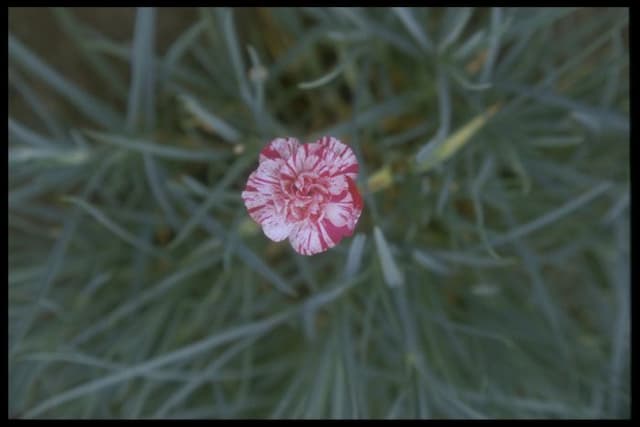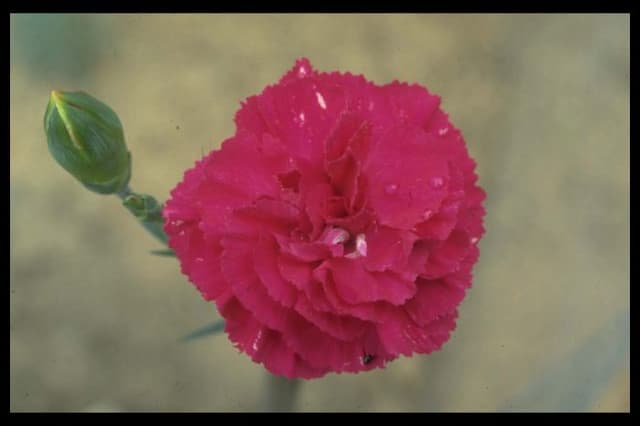Carnation Dianthus 'Carmine Letitia Wyatt' (PBR) (p)

ABOUT
Dianthus 'Carmine Letitia Wyatt' is known for its strikingly beautiful flowers and foliage. This plant has a clump-forming nature, producing dense tufts of narrow, linear leaves that are typically grey-green to blue-green in color. The leaves are slender and may have a grass-like appearance. The allure of this variety lies in its stunning flowers that bloom profusely throughout its flowering season. The blossoms are often described as having a frilly or ruffled look, which contributes to their ornamental appeal. The petals are a rich, deep pink or carmine color, which is where the plant gets its distinctive name. Each individual flower showcases a rounded shape with petals that are slightly serrated, giving them a delicate lace-like quality when viewed up close. Adding to the charm of Dianthus 'Carmine Letitia Wyatt' flowers is their delightful fragrance. The scent is sweet and spicy, typical of many in the Dianthus family, and it can be especially noticeable on warm days when the flowers seem to emit their fragrance more strongly. Overall, Dianthus 'Carmine Letitia Wyatt' presents an appealing sight in any garden, drawing attention with its vividly colored, perfumed blossoms set against the cool hues of its foliage. The flowering display is usually quite generous, creating a striking visual impact, especially when planted in groups or as part of a mixed border.
About this plant
 Names
NamesSynonyms
Carmine Letitia Wyatt Pink, Pinks, Carnation, Sweet William.
Common names
Dianthus 'Carmine Letitia Wyatt'.
 Toxicity
ToxicityTo humans
The plant commonly known as Carnation is generally not considered toxic to humans. However, ingesting any part of the plant is not advisable, as it could potentially cause mild gastrointestinal upset in some individuals. It's always best to keep plants out of reach of young children who might inadvertently eat plant parts.
To pets
Carnations are known to be mildly toxic to pets. If a pet ingests a part of a Carnation, they may exhibit symptoms such as gastrointestinal upset including vomiting or diarrhea. While this toxicity is generally considered mild, it is still important to prevent pets from eating the plant and to consult a veterinarian if any signs of poisoning are observed.
 Characteristics
CharacteristicsLife cycle
Perennials
Foliage type
Evergreen
Color of leaves
Blue-green
Flower color
Pink
Height
1-1 feet (30-30 cm)
Spread
1-2 feet (30-60 cm)
Plant type
Herb
Hardiness zones
5
Native area
Europe
Benefits
 General Benefits
General Benefits- adds vibrant color to the garden with its deep pink, carmine flowers
- suitable for cut flowers due to its long stems and durability
- attracts beneficial insects like butterflies, aiding pollination in the garden
- low maintenance, making it ideal for gardeners of all levels of experience
- drought-tolerant once established, conserving water resources
- adaptable to a variety of soil types, although it prefers well-drained conditions
- frost hardy, capable of withstanding colder temperatures without extensive protection
- ideal for use in borders, containers, and as groundcover, providing versatile landscaping options
- deer resistant, less likely to be damaged by wildlife
- has a prolonged flowering period from late spring to early autumn, offering extended visual interest
 Medical Properties
Medical PropertiesThis plant is not used for medical purposes.
 Air-purifying Qualities
Air-purifying QualitiesThis plant is not specifically known for air purifying qualities.
 Other Uses
Other Uses- As a natural dye: The petals of the Carnation can be used to create a natural dye for fabric or paper crafting, imparting a delicate pink hue.
- In homemade perfumes: Carnation petals can be infused in alcohol to make a homemade fragrance with a spicy floral note.
- As a garnish for culinary dishes: Edible Carnation petals can add a touch of elegance and color when used as a garnish on cakes, salads, and desserts.
- For crafting potpourri: Dried Carnation flowers can be mixed with other dried botanicals to create fragrant potpourri blends for the home.
- In bookmarks and paperweights: Pressed Carnation flowers can be encased within clear bookmarks or paperweights for a decorative touch.
- As a pest deterrent: Some gardeners plant Carnations among their vegetables as they believe the scent deters certain pests.
- In sachets and pillows: Dried Carnation petals can be stuffed in sachets or small pillows to impart a pleasant scent to drawers and closets.
- For floating candle displays: Carnation blooms can be floated in bowls of water as part of a centerpiece, often accompanied by floating candles for added ambiance.
- In bath salts and soaks: Carnation petals can be added to homemade bath salts or milk baths for their fragrance and skin-softening properties.
- For educational purposes: Carnation genetics are sometimes studied in classrooms to teach principles of inheritance, as their hybrid nature can result in interesting variations.
Interesting Facts
 Feng Shui
Feng ShuiThe Carnation is not used in Feng Shui practice.
 Zodiac Sign Compitability
Zodiac Sign CompitabilityThe Carnation is not used in astrology practice.
 Plant Symbolism
Plant Symbolism- Love: Dianthus, also commonly known as 'Carnations,' often symbolize deep love and affection. The rich carmine color of 'Carmine Letitia Wyatt' can represent strong, passionate feelings.
- Distinction: Carnations convey messages of distinction and fascination, making the 'Carmine Letitia Wyatt' a symbol of someone's admirable and notable qualities.
- Devotion: The long-lasting nature of carnations makes them symbols of enduring dedication and devotion.
- Admiration: Lighter shades of carnations, such as pink, are commonly given to express admiration. 'Carmine Letitia Wyatt', with its vibrant color, could similarly be used to show deep admiration.
 Water
WaterCarnations, including Dianthus 'Carmine Letitia Wyatt', prefer even moisture, but they do not like to sit in wet soil. They should be watered deeply once or twice a week, depending on the climate and soil drainage, allowing the soil to dry slightly between waterings. It's essential to avoid overhead watering to prevent disease. Typically, watering with about one gallon of water per plant each time should suffice, ensuring that the water penetrates deeply into the soil to encourage deep root growth.
 Light
LightCarnations thrive best in full sun conditions, where they can receive at least six to eight hours of direct sunlight daily. An ideal spot for Dianthus 'Carmine Letitia Wyatt' would be in a garden bed that has clear, unfiltered access to sunlight throughout the day. While they can tolerate some light shade, too little sunlight may result in weak stems and fewer blooms.
 Temperature
TemperatureCarnations can tolerate a range of temperatures but perform best in cooler conditions between 60 to 70 degrees Fahrenheit. They can survive minimum temperatures down to around 40 degrees Fahrenheit but are not frost-hardy. During hot temperatures above 85 degrees Fahrenheit, it's important to ensure they have enough water and are not exposed to intense afternoon heat to prevent stress.
 Pruning
PruningPruning carnations is essential to promote bushy growth and to prolong the blooming period. For Dianthus 'Carmine Letitia Wyatt', deadheading, or removing spent flowers, encourages additional blooms. Additionally, trim back the foliage by one-third in late summer to rejuvenate the plant. The best time for major pruning is early spring or after the first flush of flowers has faded.
 Cleaning
CleaningAs needed
 Soil
SoilThe ideal soil mix for growing Carnation (the common name of Dianthus 'Carmine Letitia Wyatt') should be well-draining and fertile, with a pH range of 6.0 to 7.5. A mixture of one part garden soil, one part compost or well-rotted manure, and one part sand or perlite is recommended to provide the proper nutrition and drainage.
 Repotting
RepottingCarnations do not require frequent repotting and can thrive in the same pot for several years. Generally, repot them every 2-3 years or when you notice the soil has degraded or the plant has outgrown its current container.
 Humidity & Misting
Humidity & MistingCarnation prefers moderate ambient humidity levels, ideally between 40-60%. They can tolerate lower humidity environments as long as their soil moisture needs are met without overwatering.
 Suitable locations
Suitable locationsIndoor
Place Carnation in bright, indirect light and ensure good air circulation.
Outdoor
Plant Carnation in full sun, well-drained soil, shelter from strong winds.
Hardiness zone
5-9 USDA
 Life cycle
Life cycleThe Dianthus 'Carmine Letitia Wyatt' typically begins its life cycle when seeds are sown in late spring to early summer, or young plants are established. Germination occurs under warm conditions and is followed by the vegetative growth phase, wherein the plant develops its root system and foliage. As the plant matures, it enters the flowering stage, usually in late spring to summer, producing its characteristic pink to carmine flowers which attract pollinators for reproduction. After pollination, the plant may produce small capsules containing seeds, completing the reproductive cycle. The Dianthus 'Carmine Letitia Wyatt' is a perennial, so after flowering, it may enter a period of dormancy in the cooler months, conserving energy and resources. With the arrival of favorable conditions in the next season, the plant resumes growth, continuing its cycle for several years.
 Propogation
PropogationPropogation time
Spring-Early Summer
Dianthus 'Carmine Letitia Wyatt', commonly known as Pinks, is generally propagated through softwood cuttings in late spring or early summer. To propagate this way, select a healthy, non-flowering stem from the parent plant and cut a piece roughly 4 inches (about 10 centimeters) long. The bottom inch of the cutting should be stripped of leaves, and the cut end can be dipped in rooting hormone for better results. The cutting is then placed in a well-draining soil mix, ensuring the leafless part is buried. It's crucial to keep the soil moist but not waterlogged, as this can cause the cutting to rot. The cutting should be kept in a warm place with indirect light until it has rooted, which usually takes a few weeks. Once the cutting has established a robust root system, it can be transplanted into the garden or a permanent container.





![Pink [Coconut Sundae]](/_next/image?url=https%3A%2F%2Fplants-admin.emdemapps.com%2Fimages%2Fplants%2F%2Fimages%2F604b5d09d4fd1.png&w=640&q=75)



